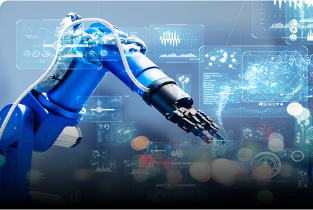The supply chain industry is undergoing a digital transformation, with IoT (Internet of Things) and robotics playing a crucial role in enhancing efficiency, accuracy, and productivity. As businesses strive to meet growing consumer demands, these technologies are revolutionizing operations worldwide. Let’s explore how IoT and robotics are reshaping the global supply chain.
The Role of IoT in Supply Chain Management
IoT refers to a network of interconnected devices that collect and exchange data in real time. In the supply chain, IoT enables businesses to monitor operations, track shipments, and optimize logistics. Key benefits include:
1. Real-Time Tracking and Visibility
IoT-powered sensors and GPS tracking allow companies to monitor shipments and inventory levels in real time. This enhances transparency and reduces the risk of delays or losses.
2. Predictive Maintenance
IoT helps in predicting machinery failures before they occur, minimizing downtime and reducing maintenance costs. Sensors in warehouses and manufacturing plants detect wear and tear, ensuring timely servicing.
3. Optimized Inventory Management
By leveraging IoT devices, businesses can automate inventory tracking, reducing human error and ensuring efficient stock management. Smart shelves and RFID tags provide instant updates on stock levels.
4. Enhanced Fleet Management
IoT-enabled fleet tracking optimizes delivery routes, monitors fuel consumption, and ensures timely maintenance of transportation vehicles, leading to cost savings and improved efficiency.
The Role of Robotics in Supply Chain Automation
Robotics is playing a crucial role in transforming supply chain processes by improving speed, accuracy, and labor efficiency. Key applications of robotics include:
1. Automated Warehouses
Autonomous robots, such as robotic arms and AGVs (Automated Guided Vehicles), streamline warehouse operations by picking, packing, and transporting goods with minimal human intervention.
2. Smart Sorting and Packaging
AI-powered robots can sort, pack, and label items efficiently, reducing processing times and increasing order fulfillment accuracy.
3. Drones for Last-Mile Delivery
Delivery drones are being deployed to enhance last-mile logistics, particularly in remote areas. They reduce delivery times and lower transportation costs.
4. Collaborative Robots (Cobots)
Cobots work alongside human workers in warehouses and manufacturing units to enhance productivity and safety while reducing operational costs.
The Future of IoT and Robotics in Supply Chain
The integration of IoT and robotics in the supply chain is expected to evolve further with advancements in AI, machine learning, and blockchain technology. In the near future, we can expect:
- Greater automation in warehouses and logistics centers
- More widespread use of AI-driven analytics for decision-making
- Blockchain-enhanced supply chain transparency
- Fully autonomous delivery networks
Conclusion
IoT and robotics are revolutionizing the global supply chain by improving efficiency, reducing costs, and enhancing accuracy. As technology continues to evolve, businesses that embrace these innovations will stay ahead of the competition, ensuring faster, more reliable, and smarter supply chain operations.

